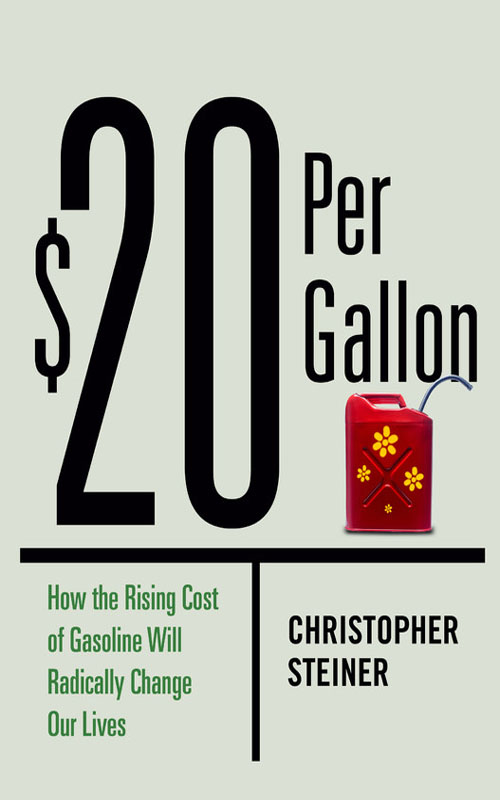Copyright 2009 by Christopher Steiner
All rights reserved. Except as permitted under the U.S. Copyright Act of 1976, no part of this publication may be reproduced, distributed, or transmitted in any form or by any means, or stored in a database or retrieval system, without the prior written permission of the publisher.
Grand Central Publishing
Hachette Book Group
237 Park Avenue
New York, NY 10017
Visit our website at www.HachetteBookGroup.com.
www.twitter.com/grandcentralpub
First eBook Edition: July 2009
Grand Central Publishing is a division of Hachette Book Group, Inc.
The Grand Central Publishing name and logo is a trademark of Hachette Book Group, Inc.
ISBN: 978-0-446-56202-7
for
Sarah and Jackson
&
Gary and Janet
O il and gasoline are mercurial commodities. The year 2008 saw oil prices touch highs that most thought wouldnt occur until decades in the future. The same year also brought prices collapsing to lows that hadnt been seen for more than four years. Gas prices can swing capriciously with the throes and fortunes of the world economy. Predicting gasolines price, during the short term, is a game of chance. Long term, however, there is only one sane prediction for gasoline prices: up.
Most of us can agree, as the facts and considerable bounty of research show, that oil is a finite resource that we use at a gluttonous pace. This book goes beyond the mere acknowledgment of peak oil. This book is the next step in the conversation. This book examines how our everyday lives will change as the price of gasoline gradually escalates. What will life look like with gas that costs $8 per gallon? $10 per gallon? $18 per gallon? Our homes, our cars, our jobs, our vacationsthroughout they will all change, step by step, with the price at the pump.
In that spirit, Ive worked hard to find people who grasp our futures, people who can map out our lives as they change with the price of gasoline. The following pages form a thought experiment on the what-ifs of high gas prices with a focus on tangible changes rather than abstract ones.
February 2009
The Road to $20 and
Civilization Renovation
W e used to turn to the weather when all else failed us as conversationalists. Clouds and sun, however, have been relegated to the backseat of chitchat lulls. Everyone wants to talk about the price of gasoline. Even if you dont drive, this is fascinating fodder. Yes, the calamitous increases and the more sudden decreases of gasoline prices have been interesting to us purely as an economic curiosityhow can something thats been around for so many years, in such utter abundance, suddenly see its value rise and fall with such confounding volatility? But theres more to our interest than cerebral economics. The tales of gas price flux have regaled our nation in the manner that J. K. Rowling or Stephenie Meyer tames adolescents. You cannot open a newspaper, national or local, that doesnt feature a prominent story with some angle on gas prices. And as it turns out, were not lemmings tethered to a petrol spigot. We have limits, and some of them have been reached. During 2008, a year when gas prices touched historical highs, Americans drove 100 billion fewer miles than they did the year before. Thats the first such decrease in thirty years, and easily dwarfs the driving decreases during the 1970s oil embargoes.
Theres something guttural, something personal, about the price of gas. Even though weve pared our driving, theres a feeling that theres more to this, more than $2 versus $4, more than the price of our weekly fill-up. At the gas pump, were egregiously offended by big numbers and comforted by small ones. Big numbers make us sick. But why? The price of commodities, the price of nearly everything we use in abundance, has shot up during the last five years. So what makes gasoline so special? We dont have the same visceral reaction to, say, the price of graineven though it goes into half of everything we eat and its price has more than doubled in recent years. Why does gasoline set off different, shriller alarms than other things we consistently buy? Perhaps thats our human intuitionan evolved sense that theres more to a situation than the mere face of it.
It turns out that our sense of intuition, honed by millennia of survival, is quite canny. The inexorable rising price at the pump represents several worlds of change beyond smaller cars and more cumbersome gas station charges. The price of oiland thus, gasolineaffects our lives to a degree few realize. Its not just the BP or Shell portion of your Visa bill. Its the bricks in your walls, the plastic in your refrigerator, the asphalt on your roads, the shingles on your roof, the synthetic rubber in your ball. With every penny that gasoline moves up, so, too, does the price of most things we consume.
Stop what youre doing. Look around. Look on your desk, at your shoes, at your shirt, at your windows, your kitchenhow much of it comes from oil? More than you think. Look out your window look out at the worldhow much of it owes its existence to oil? Again, more than you think. The United States imports 67% of its oil, but only 40% of that goes into our vehicles fuel tanks. The rest is used to make, fortify, and shape just about anything you can imagine.
Consider Bill McPetroman of Suburbia, USA, 2009
Bill lives like many of us do. Hes an American suburbanite with a good job, nice house, nice family. Bill isnt rich, Bill isnt poor. Lets examine a typical Bill morning in 2009 as he gets up for a day at the office. For simplicitys sake, Bills wonderful wife and children, who, let it be known, enjoy gasoline as much as he does, are on vacation at the family cabin; Bill will be joining them there this weekend.
Its Thursday morning. Bill gets up at 7 a.m. to the sound of his Sony clock radio, which is encased in plastic made from hydro-carbon molecules ripped from sweet crude oil at a Houston refinery. Just about everything plastic in our lives is made in a similar process with one main source: oil and its derivatives.
Bill rolls off his sheets, and puts his feet on the carpeted floor, whose fibers are made of nylon, one of the original and most successful plastics made from petrochemicals. He pads to the bathroom and puts a hand on his bathroom countertop, made of DuPonts Corian, a common household countertop material that is largely acrylic. DuPont makes Corian with a series of bonds between pigments, binders, and polymethyl methacrylate, a petro-chemical, which, of course, comes from an oil refinery.
Bill generously lathers his face with shaving cream that smells like a man should smell. The lather, incidentally, is formed by an endless list of ingredients; one of its major building blocks, however, is polymethyl methacrylate, which, of course, comes from oil. Smoothly shaven, Bill pulls his nylon shower curtain back and hops into his bathrooms attractive preformed shower stall, made of chlorinated polyethylene, another one of those ubiquitous petro-chemicals. Bill washes his hair with shampoo and conditioners made mostly of goopy hydrocarbons, linked and processed from oil; the same goes for his bar of soap. The plastic bristles and handle on his toothbrush, too, came from black gold.
Bill dresses and heads to the kitchen for breakfast. He shuffles across the kitchen floor, installed during a recent renovation; its a beautiful engineered oak floor. This kind of floor holds up to all sorts of abuse and features a thin layer of oak, about one-eighth of an inch, glued on top of a rigid and burly pad of plywood. This common type of floor earns higher durability ratings than pure wood. Its held together with binders and glue that come almost exclusively from petrochemical plants processing crude oil.

















